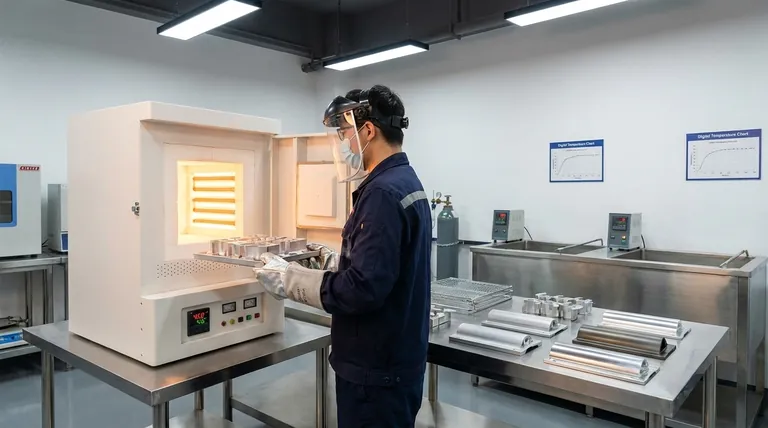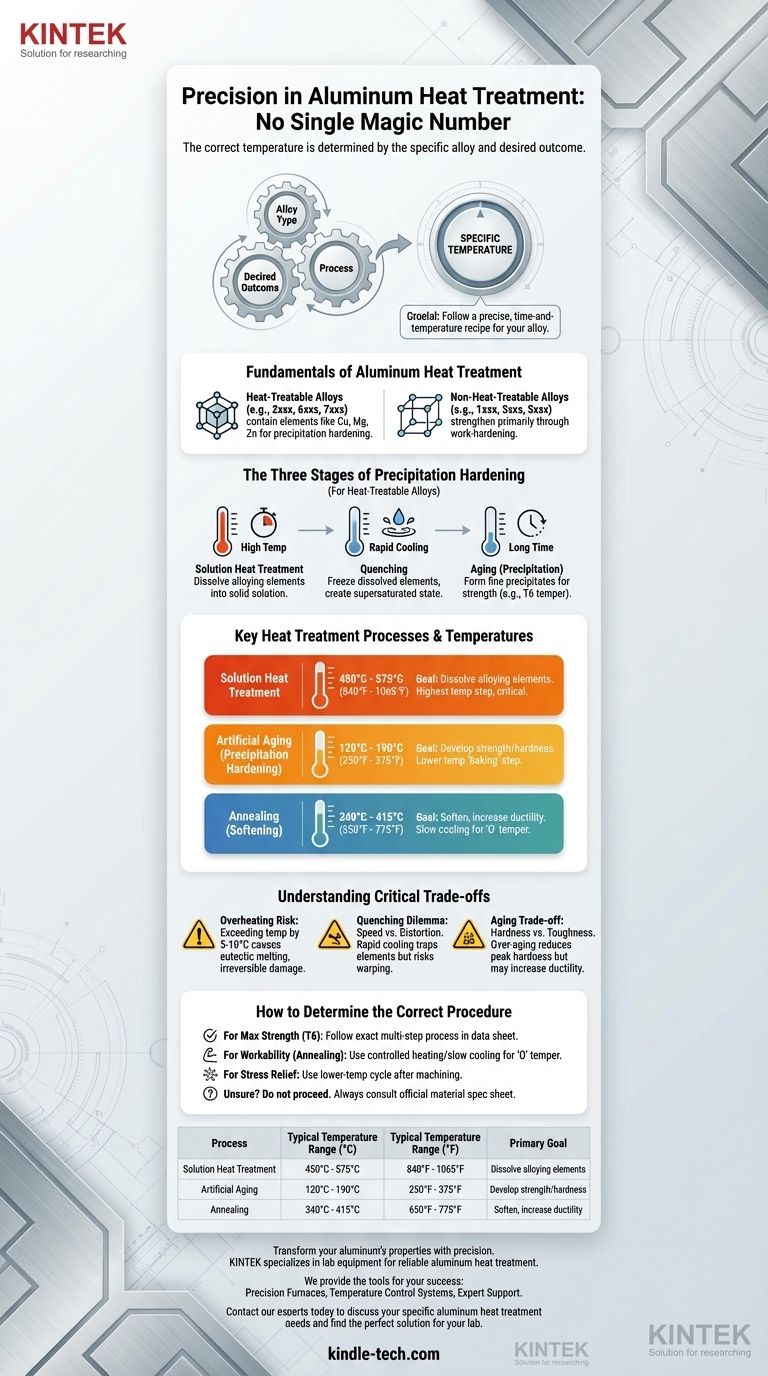To be clear, there is no single temperature for heat treating aluminum. The correct temperature is determined entirely by the specific aluminum alloy and the desired outcome, with processes ranging from as low as 120°C (250°F) for aging to as high as 575°C (1065°F) for solution treating. Using the wrong temperature, even by a small margin, can fail to achieve the desired properties or permanently damage the material.
The central principle of aluminum heat treatment is not finding one magic number, but following a precise, time-and-temperature recipe specific to your alloy and your goal, whether that is hardening, softening, or stress relieving.

The Fundamentals of Aluminum Heat Treatment
To understand the temperatures, you must first understand the different processes and why not all aluminum responds the same way. The treatment you choose dictates the temperature you use.
Why Not All Aluminum Can Be Hardened
Only certain aluminum alloys, known as heat-treatable alloys, can be significantly strengthened through heat treatment. These typically fall into the 2xxx, 6xxx, and 7xxx series, which contain alloying elements like copper, magnesium, and zinc.
These elements allow for a strengthening mechanism called precipitation hardening. Non-heat-treatable alloys (like the 1xxx, 3xxx, and 5xxx series) do not have the right chemistry for this and are strengthened primarily through work-hardening (strain).
The Three Stages of Precipitation Hardening
For heat-treatable alloys, achieving maximum strength (like a T6 temper) is a three-step process. Each step is critical.
- Solution Heat Treatment: The aluminum is heated to a high, uniform temperature to dissolve the alloying elements into a solid solution, much like dissolving sugar in hot water.
- Quenching: The material is rapidly cooled, usually in water, to "freeze" the dissolved elements in place. This creates a supersaturated state.
- Aging (or Precipitation): The material is held at a lower temperature for an extended period. This allows the alloying elements to precipitate out of the solution as extremely fine, dispersed particles that impede dislocation movement, dramatically increasing strength and hardness.
Key Heat Treatment Processes and Their Temperatures
Each process has a specific temperature range that must be precisely controlled. The following are typical ranges for common alloys like 6061 or 7075; however, always consult the material data sheet for your specific alloy.
Solution Heat Treatment
This is the highest-temperature step and the most critical. Its purpose is to put the hardening alloys into solution.
The temperature must be hot enough to dissolve the elements but below the point where any part of the alloy begins to melt (the eutectic melting point). Typical temperatures are between 450°C and 575°C (840°F to 1065°F).
Artificial Aging (Precipitation Hardening)
This is the lower-temperature "baking" step that develops the final strength after quenching. It is what turns a T4 temper into a stronger T6 temper.
This process is a function of both time and temperature. Typical aging temperatures range from 120°C to 190°C (250°F to 375°F), with holding times from a few hours to over a day. Higher temperatures require shorter times, but may not produce optimal properties.
Annealing (Softening)
Annealing is used to put aluminum in its softest, most ductile state (the 'O' temper). This is often done to make the material easier to form or to relieve the effects of work-hardening.
The part is heated to a uniform temperature, typically between 340°C and 415°C (650°F and 775°F), and then cooled very slowly. The slow cooling allows the crystalline grain structure to reform into a low-stress state.
Understanding the Critical Trade-offs
Heat treating aluminum is a precise science where small deviations can lead to major failures. Understanding the risks is as important as knowing the temperatures.
The Danger of Overheating
During solution treatment, exceeding the recommended temperature—even by 5-10°C—can cause eutectic melting. This creates permanent, brittle microstructures at the grain boundaries, ruining the part's structural integrity. The damage is not visible and cannot be repaired.
The Quenching Dilemma: Speed vs. Distortion
A fast quench is necessary to trap the alloying elements in solution. However, the extreme thermal shock of rapid cooling can cause significant warping and internal stress, especially in complex parts. The choice of quenchant (water, polymer, forced air) is a trade-off between achieving full hardness and maintaining dimensional stability.
Aging: Hardness vs. Toughness
During artificial aging, the material reaches a point of peak hardness (T6 temper). If you continue to heat it beyond this point ("over-aging"), the fine precipitates will begin to grow and coarsen. This reduces hardness and strength but can sometimes increase ductility and resistance to stress-corrosion cracking.
How to Determine the Correct Procedure
The right approach depends entirely on your specific material and your engineering goal.
- If your primary focus is achieving maximum strength (T6 Temper): You must follow the exact multi-step process of solution treatment, rapid quenching, and artificial aging detailed in the data sheet for your specific alloy.
- If your primary focus is making the material workable (Annealing): Use a controlled heating and slow cooling cycle to reach the 'O' temper, which will maximize ductility for forming operations.
- If your primary focus is removing stress after machining: A lower-temperature stress relief cycle, which is less extreme than a full anneal, is often sufficient.
- If you are unsure of the alloy or process: Do not proceed. Guessing temperatures or times will lead to failure. Always obtain the official material specification sheet.
Ultimately, precision is the key to successfully transforming the properties of aluminum through heat.
Summary Table:
| Process | Typical Temperature Range (°C) | Typical Temperature Range (°F) | Primary Goal |
|---|---|---|---|
| Solution Heat Treatment | 450°C - 575°C | 840°F - 1065°F | Dissolve alloying elements |
| Artificial Aging | 120°C - 190°C | 250°F - 375°F | Develop strength/hardness |
| Annealing | 340°C - 415°C | 650°F - 775°F | Soften, increase ductility |
Transform your aluminum's properties with precision.
Achieving the exact mechanical properties you need—whether maximum strength (T6 temper), improved ductility (O temper), or stress relief—requires precise temperature control. KINTEK specializes in the lab equipment and consumables necessary for reliable aluminum heat treatment, serving laboratories and materials engineers who demand accuracy and repeatability.
We provide the tools for your success:
- Precision Furnaces: For accurate solution treatment and aging cycles.
- Temperature Control Systems: To maintain the critical temperatures your alloy requires.
- Expert Support: To help you select the right equipment for your specific aluminum alloys and processes.
Don't risk eutectic melting or suboptimal properties. Let KINTEK be your partner in materials science. Contact our experts today to discuss your specific aluminum heat treatment needs and find the perfect solution for your lab.
Visual Guide

Related Products
- 1200℃ Muffle Furnace Oven for Laboratory
- Vacuum Heat Treat and Pressure Sintering Furnace for High Temperature Applications
- Graphite Vacuum Furnace Negative Material Graphitization Furnace
- Horizontal High Temperature Graphite Vacuum Graphitization Furnace
- Graphite Vacuum Continuous Graphitization Furnace
People Also Ask
- What is ashing in chemistry? Enhance Analytical Accuracy with Ashing Techniques
- Why does heating increase temperature? Understanding the Molecular Dance of Energy Transfer
- What is the process of sintering in ceramic materials? A Guide to Transforming Powder into High-Strength Parts
- What crucible is used in muffle furnace? Select the Right Material for Your Application
- What is the purpose of sintering in powder metallurgy? Transform Powder into High-Strength Parts



















